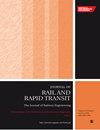Long railway track modelling – A parallel computing approach
IF 2.1
4区 工程技术
Q3 ENGINEERING, CIVIL
Proceedings of the Institution of Mechanical Engineers Part F-Journal of Rail and Rapid Transit
Pub Date : 2024-09-07
DOI:10.1177/09544097241280098
引用次数: 0
Abstract
This paper presents the development of a dynamics model for long track sections. It is based on an established short track model that utilises the Finite Element Method to describe rails and block models to describe sleepers, ballast and subballast. By implementing a parallel computing method, this innovation enables the construction of a true long track model: by segmenting the long track into shorter segments that are easier to compute. The model facilitates simulations to be run in parallel, thereby permitting simultaneous calculations of various numerical track variables. The model employs a Message Passing Interface framework to seamlessly link the track segments, handling the flow of data among the computing cores designated to each subdivided section. This strategic framework allows the long track model with the capability to simulate tracks of virtually any length, with the only constraints being the available computational resources and time. The claimed contribution about modelling capability is verified using two case studies on a 6km-long track involving different practical and conceptual train operational scenarios: emergency braking and constant braking force with constant train speed. These case studies show the flexibility and scalability of the method and its capability to handle complex track dynamic systems.长铁路轨道建模 - 一种并行计算方法
本文介绍了长轨段动力学模型的开发情况。该模型以已建立的短轨道模型为基础,利用有限元法描述钢轨,并利用块模型描述枕木、道碴和底碴。通过采用并行计算方法,该创新技术能够构建真正的长轨道模型:将长轨道分割成更易于计算的较短轨道段。该模型便于并行模拟,从而允许同时计算各种轨道数值变量。该模型采用消息传递接口框架无缝连接轨道段,处理指定给每个细分部分的计算核心之间的数据流。这一战略框架使长轨道模型能够模拟几乎任何长度的轨道,唯一的限制因素是可用的计算资源和时间。在一条 6 千米长的轨道上进行的两个案例研究验证了建模能力的贡献,这两个案例研究涉及不同的实际和概念列车运行场景:紧急制动和恒定制动力与恒定列车速度。这些案例研究显示了该方法的灵活性和可扩展性,以及处理复杂轨道动态系统的能力。
本文章由计算机程序翻译,如有差异,请以英文原文为准。
求助全文
约1分钟内获得全文
求助全文
来源期刊

CiteScore
4.80
自引率
10.00%
发文量
91
审稿时长
7 months
期刊介绍:
The Journal of Rail and Rapid Transit is devoted to engineering in its widest interpretation applicable to rail and rapid transit. The Journal aims to promote sharing of technical knowledge, ideas and experience between engineers and researchers working in the railway field.
 求助内容:
求助内容: 应助结果提醒方式:
应助结果提醒方式:


